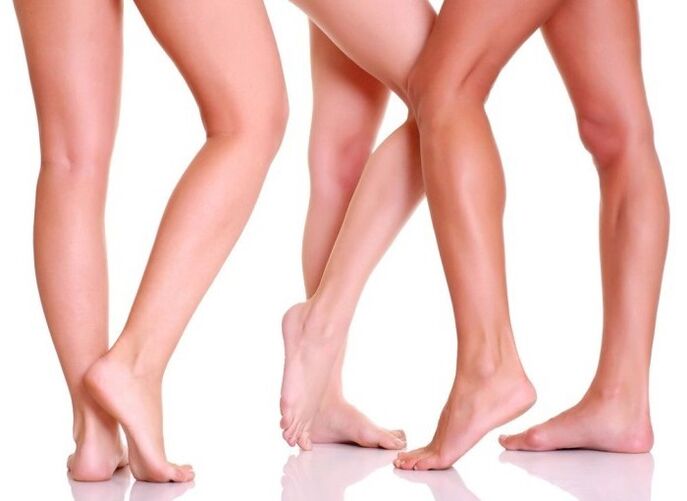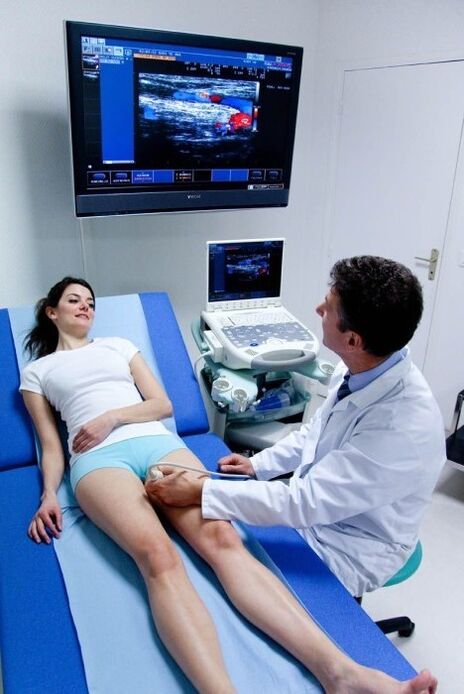Thanks to veins, blood from the human body flows to the heart. Varicose veins of the lower extremities cause the veins to dilate and lengthen. This disease is widespread today. Women aged thirty to forty are the ones who suffer most from this. Let's take a closer look at why varicose veins develop in the legs, how they are diagnosed and treated.

Why does the disease develop?
Varicose veins in the lower extremities develop gradually. It is facilitated by several factors unfavorable to the veins, which over time make themselves felt in the form of the formation of nodules and meshwork.
Reasons why varicose veins develop in legs:
- Overweight;
- The intestines cannot cope with their work, which is why constipation often occurs;
- Flat foot;
- High pressure;
- Passive lifestyle;
- Great physical activity;
- Prolonged tension in the legs.
Due to excess weight, the legs experience great stress, which leads to stagnation of blood in the veins. In addition, if the intestines function poorly, the functioning of all organs and systems in the human body will be disrupted. Since blood travels a long way before returning to the heart from the lower extremities. And if the intestine works intermittently, the venous blood will not be able to return to the top, which leads to stagnation in the legs.
In addition to the factors described above, the development of the disease is also facilitated by diseases of the pelvic organs and hormonal imbalances with pregnancy, stress, antibiotics, alcoholic beverages and smoking.
Varicose veins of the lower extremities are inherited at the genetic level. Because it is transmitted from parents, children can begin to suffer from varicose veins from a young age. Therefore, it is important to carry out disease prevention, which will help prevent the disease and prevent the development of serious complications.
Symptoms and diagnosis of the disease
The main symptoms of varicose veins in the legs are the following:
- Swelling of the legs at the end of the work day;
- Feeling of fullness and heaviness in the calf region after sitting or standing in the same place for a long time;
- Tingling in the legs;
- The appearance of cyanosis on the legs;
- Formation of networks and stars on the legs.
If these symptoms appear, it is important to urgently consult a phlebologist or vascular surgeon. If you start treatment in a timely manner, you can prevent complications from developing.

The specialist will carefully examine the patient and listen to complaints. He will also prescribe all tests and carry out the necessary examinations. To accurately diagnose and prescribe the correct and effective treatment, the doctor prescribes the following studies:
- Ultrasound examination of the veins, called duplex vein scanning. Thanks to ultrasound, an experienced specialist will see the state of patency of the veins, as well as how dilated they are. Additionally, this study will tell if there are blood clots in the veins and in which direction the blood flows;
- Using contrast venography, varicose veins of the lower extremities can be accurately diagnosed. Thanks to venography, the condition of the veins is assessed, the presence of blood clots and tumors is determined. During this study, a substance is injected into the leg region that colors the blood blue, which allows an impression of the patient's veins to be made on the x-ray.
Most often, vein examination is performed using duplex scanning.
When to see a doctor urgently
As varicose veins are dangerous to the human body, it is important to seek medical help urgently when the following situations occur:
- If intense and sharp pain in the legs occurs with any movement;
- If in the morning, when you want to get out of bed, you feel a sharp pain in your leg. In this case, the leg looks swollen and dense and the skin burns;
- If, in addition to pain, there is weakness throughout the body, shortness of breath and a constant feeling of oxygen deficiency;
- If the leg affected by varicose veins starts oozing blood.
The above symptoms force a person to immediately consult a doctor to avoid undesirable consequences.
Correctly treat varicose veins
Taking into account the advanced stage of the disease, emerging complications associated with varicose veins, as well as the patient's age, the doctor prescribes conservative or surgical treatment.
Varicose veins are treated using the following methods:
- Treatment of the disease without surgery. This treatment method is effective only at the first symptoms of varicose veins. Conservative treatment methods include wearing special compression garments, adhering to a special diet, and regularly engaging in a range of physical activities.
On the advice of a doctor, you can choose special knee-high or foot socks with a certain compression. You can also wrap your legs with elastic compression bandages. This underwear should be worn throughout the day and removed only before going to sleep.
A special massage is also useful, carried out using special cuffs filled with air. Thanks to pneumomassage, blood circulation improves, tissues breathe better, pain and discomfort associated with varicose veins disappear;
- The treatment of varicose veins in the lower limbs also occurs with the help of medications, which in turn are divided into venotonics, anticoagulants and non-steroidal anti-inflammatory drugs.
Anticoagulants prevent blood clots from forming in the veins.
Thanks to non-steroidal anti-inflammatory drugs, inflammation and pain are eliminated.
- Varicose veins are also treated with leeches. Leeches bite into the skin, dig into it and release hirudin, which thins the blood and prevents the formation of blood clots;
- Sclerotherapy treatment, in which the affected veins are completely removed. The procedure is like this. The doctor injects a special medicine into the vein, which glues the veins together and stops the flow of blood. Because of this, degradation of the veins occurs. The vein resolves completely within a year. This procedure does not interfere with blood circulation. To completely cure varicose veins with sclerotherapy, you need to undergo three to six sessions;
- Varicose veins are also treated with a laser. The procedure is performed under local anesthesia. The first results will be visible three weeks after treatment;
- If the conservative methods described above do not produce results, the doctor resorts to surgical treatment. On the second day after surgery, the patient can walk independently.
The method of treating varicose veins in your case should be determined by the doctor individually. There is no need to self-medicate such a serious illness.
professional advice
Doctors advise all patients who come to them with varicose veins the following:
- Try to drink more than two liters of purified water every day. Water helps you lose excess weight and also prevents the development of varicose veins;
- It is important to do a fasting day once a week. On this day you need to fast. A one-day fast will help cleanse the body of waste and toxins;
- Try to stop smoking. After all, nicotine harms blood vessels and causes the development of varicose veins;
- Try not to overheat and strengthen your immune system so as not to get sick. Don't sit in a hot bath or sauna for a long time;
- It is not recommended to change the climate suddenly. Therefore, it is better to relax in your own climatic zone.
The simple tips listed will help prevent varicose veins and will also make it easier to manage if the disease has already affected your legs.
Varicose veins and traditional medicine
It is necessary to start treating varicose veins with folk recipes only after consulting a doctor and in parallel with a conservative method of treatment. Traditional medicine recipes that will help get rid of the disease:
- Mix one part minced white garlic with two parts butter cream. Apply the resulting product to the damaged veins, wrap the leg with parchment paper and a warm bandage or scarf. This compress is done at night. In the morning, wash and put on warm pants;
- For a year, before going to sleep, tie slices of green tomato to the affected veins. Thanks to the vegetable, varicose veins will become soft and decrease in size. And after a while they will disappear completely;
- Mix sour milk with wormwood. Put the resulting mixture in a bandage and wrap it around your legs. The procedure is performed overnight;
- To prevent your legs from hurting from varicose veins at night, you need to eat the following apple porridge. Pour three Antonovka apples with a liter of boiling water and let it brew for three hours. Then, remove the apples and make a puree with them, which should be consumed twice a day, 30 grams;
- Pour boiling water over 30 grams of nettle and let it brew for an hour. Then strain and drink a quarter cup three times a day. Drink for 1 month, then take a break for two weeks and repeat the course. Nettle treatment must be carried out for six months;
- Pour boiling water over the hop cones and let steep for 15 minutes. Drink the tincture half an hour before meals. For faster results, soak the bandages in the intoxicating infusion and apply to the affected veins;
- Pour boiling water over 5 grams of chopped nutmeg. Add 5 grams of honey and stir. Let it ferment for 30 minutes. Drink 60 minutes before your morning meal and two hours after. Nutmeg is poisonous, so you can drink no more than five grams per day. Failure to comply with this warning may result in death;
- Place Kalanchoe leaves in a liter jar. Half leaves and half alcohol. Infuse for two weeks in the dark. Shake the bottle every day. Lubricate your feet daily with the resulting product;
- You need to peel five potatoes. Grate them and brush the feet with the resulting puree. After four hours, rinse the potatoes with warm water;
- Pour 50 grams of horse chestnut with alcohol (500 milliliters). Let it ferment for two weeks. After a while, strain and drink 15 grams three times a day with water. The course of treatment is 7 days. Then a 14-day break. After completing just three of these courses, your legs will improve.
It is important to remember that the described traditional medicine treatment methods can only be used after consulting a doctor, so as not to aggravate the situation and not harm your health.
Dietary rules for varicose veins
Try to eat foods that contain fiber every day. Thanks to fiber, excess and unnecessary substances are removed from the body. Fiber deals with toxins, waste, pus and even radionuclides. It is also sometimes called an intestinal cleanser. Therefore, it is useful to eat various cereals and vegetable and fruit peels.
If you eat only barley porridge for a few days, you can get rid of extra pounds, remove swelling and improve the condition of your skin and hair.
To lose excess weight and improve blood circulation in your legs, try to consume less animal fats. They can be replaced with vegetable oils, which improve blood flow and are therefore considered useful for varicose veins in the legs. To prevent obesity, increased cholesterol and waste products in the body, exclude fast food and fast food products from your diet.
It is very useful to consume foods enriched with vitamin C, which strengthens the walls of the veins and improves immunity. Vitamin C can be found in citrus fruits, hawthorn, rose hips, black currants, onions and garlic.
Now you know why varicose veins of the lower extremities develop, how they can be correctly diagnosed and what treatment is offered for this disease. Only by strictly following all the recommendations of an experienced doctor will you be able to overcome this disease in a short period of time and continue to live and enjoy a healthy lifestyle.

















